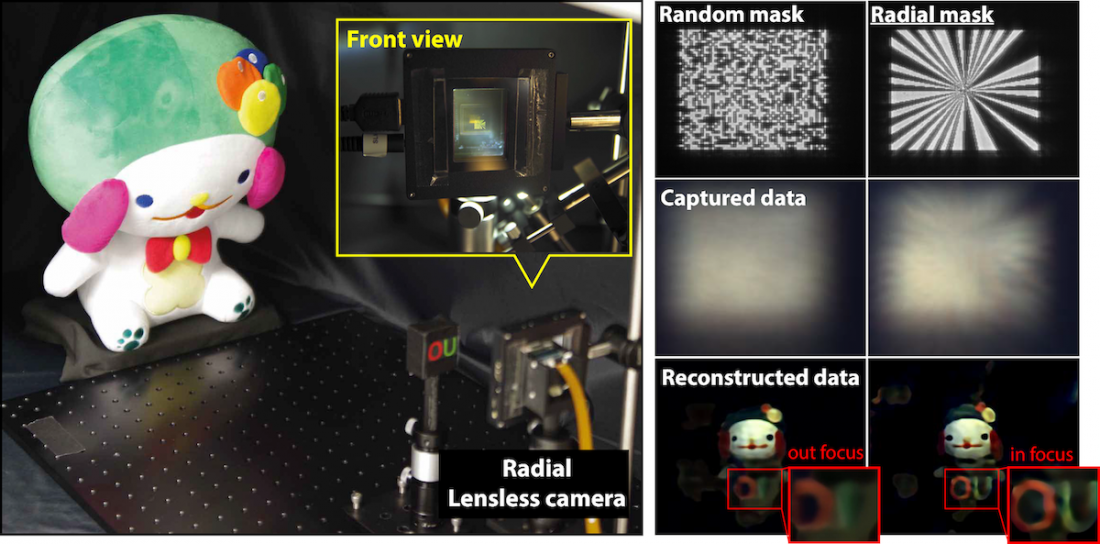Fig. Extended depth-of-field imaging by a lensless camera using an optimized radial mask.
To increase the depth of field in ultra-thin, mask-based lensless cameras, researchers from Osaka University developed and optimized a radial-coded mask that replaces conventionally coded masks and yields sharp images at a range of distances
Osaka, Japan – To take an image that is completely in focus, one of the most familiar parts of a camera – the lens – isn’t necessary anymore. Instead, a thin mask over the image sensor can do the job. But the kind of mask you use makes a huge difference to how sharp your image is.
In a study published recently in IEEE Transactions on Computational Imaging, researchers from Osaka University have described an optimized radial-coded mask with extended depth of field to sharpen objects on both the foreground and background of images.
As camera designs have become thinner and lighter, one of the main limitations has been the lens, which has to be a certain size, shape, and distance from the image sensor to focus light onto it. In lensless cameras, the sensor takes a blurry image and does the work to “focus” the image afterward using reconstruction software. It’s able to do this because the information needed to extract the image is encoded in the interaction between light and the mask in front of the sensor, which is called the point spread function.
One of the advantages of a lensless camera is that, by altering its mask in an intentional way, the camera's characteristics can be changed. For instance, its depth of field can be altered, as in this study. In conventional lensless cameras, the point spread function changes depending on the distance of the subject, and the camera can only clearly capture subjects at a certain distance in a single reconstruction process. The researchers wanted to create a lensless camera that could focus better on both foreground and background objects. That is, they wanted a camera with a large depth of field, and they found a mask with sections emanating from the center like the rays of a starburst would do the trick.
The Intelligent Media Systems group, who conducted the research at Osaka University, found that the number of sections and their thicknesses also change the characteristics. More, thinner sections highlight fine details, whereas fewer, thicker ones focus on smooth regions. Hence, the team used an optimization process to determine the mask that would work the best for all parts and found that a specific combination of thin and thicker sections was best.
The masks were tested using simulation and an actual prototype, and it was found that the depth of field was indeed extended.
Lensless cameras are smaller, thinner, and lighter than traditional cameras, and increasing the depth of field is a huge step toward developing a device that can be used in real applications such as medicine and industrial inspection. In addition, there are still many other types and arrangements of masks to explore, and this could make lensless cameras a practical and common device in the future.
###
The article, “Extended Depth-of-Field Lensless Imaging using an Optimized Radial Mask,” was published in IEEE Transactions on Computational Imaging at DOI: 10.1109/TCI.2023.3318992
About Osaka University
Osaka University was founded in 1931 as one of the seven imperial universities of Japan and is now one of Japan's leading comprehensive universities with a broad disciplinary spectrum. This strength is coupled with a singular drive for innovation that extends throughout the scientific process, from fundamental research to the creation of applied technology with positive economic impacts. Its commitment to innovation has been recognized in Japan and around the world, being named Japan's most innovative university in 2015 (Reuters 2015 Top 100) and one of the most innovative institutions in the world in 2017 (Innovative Universities and the Nature Index Innovation 2017). Now, Osaka University is leveraging its role as a Designated National University Corporation selected by the Ministry of Education, Culture, Sports, Science and Technology to contribute to innovation for human welfare, sustainable development of society, and social transformation.
Website: https://resou.osaka-u.ac.jp/en



